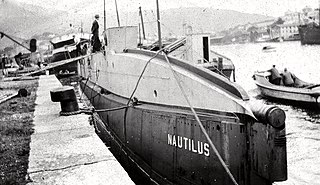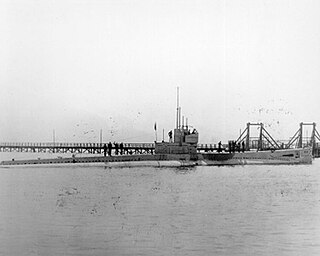
USS O-12 (SS-73) was an O-class submarine of the United States Navy. These later O-boats, O-11 through O-16, were designed by Lake Torpedo Boat to different specifications than the earlier Electric Boat designs. They performed poorly as compared to the Electric Boat units, and are sometimes considered a separate class. The ship was launched in 1917 and entered service with the Navy in 1918 in the Panama Canal Zone.

USS G-1 (SS-19½) was the lead ship of her class of submarine of the United States Navy. While the four G-boats were nominally all of a class, they differed enough in significant details that they are sometimes considered to be four unique boats, each in a class by herself.
USS Trigger (SS-564), a Tang-class submarine, was the second ship of the United States Navy to be named for the triggerfish.

USS Skipjack (SS-184), was a Salmon-class submarine, the second ship of the United States Navy to be named after the skipjack tuna. She earned multiple battle stars during World War II and then was sunk, remarkably, by an atomic bomb during post-World War II testing in Operation Crossroads. Among the most "thoroughly sunk" ships, she was refloated and then sunk a second time as a target ship two years later.

USS Bergall (SS-320), a Balao-class submarine in commission from 1944 to 1958, was the first ship of the United States Navy to be named for the bergall, a small fish of the New England coast. During World War II she made five war patrols between 8 September 1944 and 17 June 1945, operating in the South China Sea, Java Sea, and Lombok Strait and north of the Malay Barrier. During these patrols she sank two Japanese merchant ships totaling 14,710 gross register tons and one 740-displacement ton Imperial Japanese Navy frigate. She also damaged the Japanese heavy cruiser Myōkō, which was never repaired.

USS S-50 (SS-161) was a fourth-group (S-48) S-class submarine of the United States Navy.
USS S-49 (SS-160) was a fourth-group (S-48) S-class submarine of the United States Navy.

USS S-48 (SS-159) was the first submarine in the fourth group of S-class submarines of the United States Navy.

USS R-21 (SS-98) was an R-class coastal and harbor defense submarine of the United States Navy. Her keel was laid down on 19 April 1917 by the Lake Torpedo Boat Company in Bridgeport, Connecticut; the R-boats built by Lake Torpedo Boat are sometimes considered a separate class from those built by Fore River Shipbuilding and Union Iron Works. She was launched on 10 July 1918 sponsored by Mrs. Dallas C. Laizure and commissioned on 17 June 1919.

USS N-2 (SS-54) was a N-class coastal defense submarine built for the United States Navy during World War I.

USS N-4 (SS-56) was a N-class coastal defense submarine of the United States Navy. Her keel was laid down on 24 March 1915 by Lake Torpedo Boat Company in Bridgeport, Connecticut. The N-boats built by Lake had slightly different specifications from the ones built by Seattle Construction and Drydock and are sometimes considered a separate class.

USS N-5 (SS-57) was a N-class coastal defense submarine of the United States Navy. Her keel was laid down on 10 April 1915 by Lake Torpedo Boat Company in Bridgeport, Connecticut. The N-boats built by Lake had slightly different specifications from the ones built by Seattle Construction and Drydock and are sometimes considered a separate class.

USS N-6 (SS-58) was a N-class coastal defense submarine of the United States Navy. Her keel was laid down on 15 April 1915 by Lake Torpedo Boat Company in Bridgeport, Connecticut. The N-boats built by Lake had slightly different specifications from the ones built by Seattle Construction and Drydock and are sometimes considered a separate class.

USS K-7 (SS-34) was a K-class submarine built for the United States Navy during the 1910s.

USS G-4 (SS-26) was a G-class submarine of the United States Navy. While the four G-boats were nominally all of a class, they differed enough in significant details that they are sometimes considered to be four unique boats, each in a class by herself.

USS G-2 (SS-27) was a G-class submarine of the United States Navy. While the four G-boats were nominally all of a class, they differed enough in significant details that they are sometimes considered to be four unique boats, each in a class by herself. A Simon Lake design, G-2 was named Tuna when her keel was laid down on 20 October 1909 by Newport News Shipbuilding in Newport News, Virginia. She was the first ship of the United States Navy to be named for the tuna, a large, vigorous, spiny-finned fish highly esteemed for sport and food. She was renamed G-2 on 17 November 1911, launched on 10 January 1912 sponsored by Ms. Marjorie F. Miller, towed to the New York Navy Yard after the termination of the Lake contract on 7 November 1913 where she was completed, and placed in reduced commission on 1 December 1913.

The United States Navy's sixteen O-class submarines were created out of the lessons learned from the L class. The O class were about 80 tons larger than the L class, with greater power and endurance for ocean patrols. Due to the American entry into World War I the O class were built much more rapidly than previous classes, and were all commissioned in 1918. O-1 through O-10 were group 1, designed by Electric Boat, O-11 through O-16 were group 2, designed by the Lake Torpedo Boat Company and sometimes considered a separate class. The group 2 boats entered service just before the end of World War I. Eight of the group 1 boats survived to serve in World War II as training boats when they were recommissioned in 1941.
The G-class submarines were a class of four United States Navy submarines. While the four G boats were nominally all of a class, they differed enough in significant details that they are sometimes considered to be four unique boats, each in a class by herself. They were the result of agitation for competition in submarine design; all previous US submarines were designed by Electric Boat. G-1, G-2, and G-3 were designed by Simon Lake of the Lake Torpedo Boat Company, while G-4 was designed by American Laurenti. G-1 and G-2 were built by Newport News, G-3 by Lake, and G-4 by Cramp.

SM U-1 or U-I was the lead boat of the U-1-class of submarines or U-boats built for and operated by the Austro-Hungarian Navy. U-1 was designed by American naval architect Simon Lake of the Lake Torpedo Boat Company, and constructed at the Navy Yard in Pola. She was one of two Lake-designed submarines purchased as part of a competitive evaluation of foreign submarine designs after domestic proposals were rejected by the Navy.

SM U-2 or U-II was the second ship of the U-1 class of submarines or U-boats built for and operated by the Austro-Hungarian Navy. U-2 was designed by American naval architect Simon Lake of the Lake Torpedo Boat Company, and constructed at the navy yard in Pola. She was one of two Lake-designed submarines purchased as part of a competitive evaluation of foreign submarine designs after domestic proposals were rejected by the Navy.

















